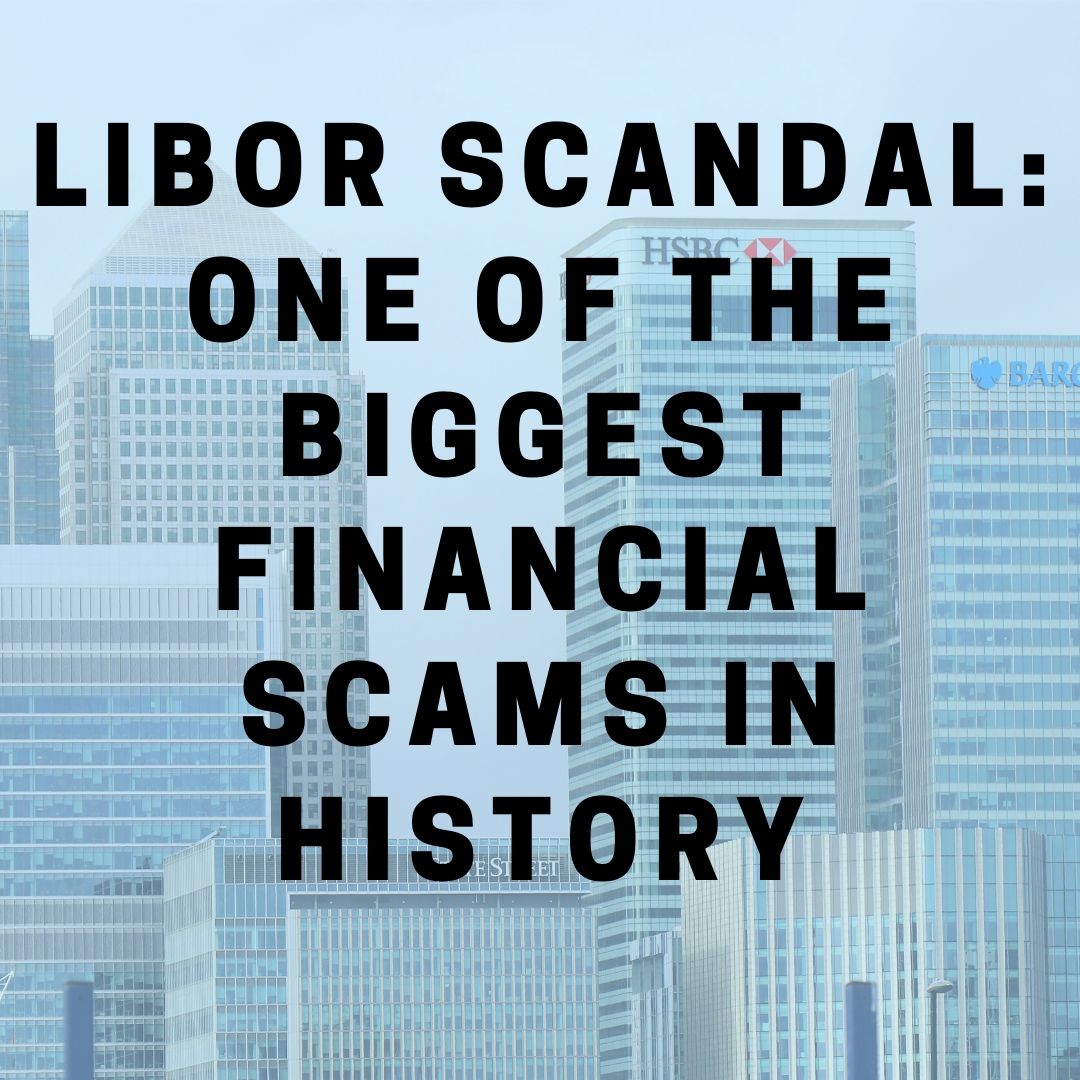Libor Scandal: One of the Biggest Financial Scams in History
- 22 April 2020 | 2498 Views | By Abhinav Mishra

A brilliant mathematician works as a trader in a big bank. He has a family, he goes around to pubs and bars and talks to strangers about random topics. To the world, he is a 9 to 5 guy who loves his work and enjoys his life. What goes in his mind is a different story. For years, he has been involved in rigging and manipulating the biggest financial platform in the world. He made millions out of it. When the truth comes out, he is sentenced to 14 years in jail. Who fights his case? His wife, who is a corporate lawyer, tries her best to save him but could not do much. How big is the scam? The banks involved in the scandal end up paying billions of dollars in penalty and some big guns lose their job.
Does it sound like a story of some movie? Well, not a movie but it is interesting enough to be written as a book – The Spider Network by David Enrich which was shortlisted for ‘Financial Times business book of the year.’
LIBOR Scandal
In this article, we are going to talk about – The wild story of a Math Genius, a gang of backstabbing bankers, and one of the greatest scams in Financial History – Libor Scandal and the man behind it, Tom Hayes.
Before we get to the scandal, it is very important to understand Libor. LIBOR stands for London Interbank Offered Rate. In a very simple language, Libor can be understood as a benchmark interest rate that some of the biggest banks charge each other for overnight, one-month, quarterly, six months and yearly loans. The rates are published by Reuters every morning at 11 am(UK)in five currencies – The Euro, Swiss Franc, the Pound sterling, the US dollar, and the Japanese Yen. Trillions of financial contracts are directly linked to these rates as it is a reference rate for loans like mortgages, credit cards, bonds, and student loans.
It is not important just for the volume of money it is linked with but also it is used as a measure of trust in the financial system and reflects the confidence certain banks have on the other banks.
Banks just cannot borrow money from each other as and when they feel like. There is a system in place. Every day, a group of leading banks submit the interest rates at which it will provide money to other banks or financial institutions. The rates are suggested in ten different currencies and covers 15 different time durations from overnight to twelve months. Then the average is calculated. So if any bank wants to borrow money on a particular day then it will have to borrow money on the average rate set for the day. This becomes the most important number of the day as it is the basis for interest rates on huge quantities of debt all over the world.
Below image shows how the average is calculated:
So now you know the system and how it works. It is time to introduce our hero/villain (you may call it whatever you feel like) of the story – Tom Hayes. He was a trader working with UBS. Like other traders, he was transacting huge volumes of derivatives that are linked to LIBOR. People like him can lose or make a lot of money with a slightest of movement in Libor on a daily basis.
He was aware of the system and he knew no one pays attention to how the Libor is set, there is no monitoring of the process. How did he use this in his favor? By asking for small favors, he would call a low profile person in his bank and ask him to move the Libor up or down by a few hundredths of a percentage point. Mostly the person agreed, not going into the details of what they get in return!
Many other traders were doing the same, but Tom took the game to the next level. He not only called people in his bank but also went to people in other competitor banks. He used brokers to reach out to more people. He took the game to the new heights and a more creative level.
What is the LIBOR Scandal all about?
By now you would have figured out the game – He traded in derivatives which are affected by Libor rates and since he had the complete network of people to manipulate the Libor rate, he was using it for his and his organization’s profit.
He was an excellent trader, in fact, genius as per people around him. What are the qualities of a good trader who makes a fortune trading in the market?
The trader identifies the inefficiencies in the market – loopholes and weaknesses. They then find ways to exploit those loopholes and weaknesses like having better information than competitors or right information at the right time or better technology or the ability to subtly nudge something that you’re trading on. Tom did just the same which will get him great pleasure and applause from the people around him.
How was LIBOR Scandal Discovered?
When was LIBOR Scandal discovered?
In 2007, Barclays raised the issue that other banks are dishonestly submitting low interbank rates and asked US regulators to look into the issue.
September 2008 – The Libor rates surge after the collapse of Lehman Brothers as the world faces global financial crises.
2010 – Financial Services Authority (organization from Britain) starts an investigation into Barclays as part of a global probe of alleged interest rate manipulation.
August 2011 – A lawsuit is filed by the then discount brokerage and the money manager Charles Schwab, against 11 major banks of the world for conspiring to manipulate Libor
June 2012 – Barclays is fined $450 million and Britain announced a review of the way Libor is calculated. The big bosses of Barclays quit in the next month over the scandal.
August 2012 – A lot of other banks are investigated including Royal Bank of Scotland, JPMorgan, HSBC Holdings, Barclays, Deutsche Bank, UBS, and Citigroup.
September 2012 – The Libor was about to get scrapped but the decision was withdrawn at the last moment by FSA.
How the Scandal Affected the Financial Market?
The biggest concern after the Libor scandal was that public trust was completely eroded. Since the banks were charged billions as penalty and private legal settlements, it raised new challenges for financial institutions that had to maintain higher reserves against another systemic crisis post-2008.
LIBOR and 2008 financial crisis
The rigging of Libor caused the 2008 financial crisis. Hedge funds and banks thought the swap would protect them from risky mortgage-backed securities. Libor is usually a few tenths of a point above the fed funds rate. In April 2008, Libor was at 2.9% while the Federal Reserve was dropped to 2%. For the most part of 2008, banks had stopped lending to each other because they feared they would inherit each other’s subprime mortgages as collateral. Libor continued to increase steadily and reflected the high cost of borrowing. In October, the Fed rates were dropped to 1.5% while Libor was to a high of 4.8%.
The Dow Jones tanked 14% because of this situation. The increase in Libor added an extra $3.6 trillion in interest being charged to borrowers. Investors got worried about the situation and only after $700 billion bailouts, Libor returned to normal levels.
Even after Libor returned to normal, banks continued to hoard cash. More than a hundred billion Euros were still being deposited in the European Central Bank (December 2008). Why? Because everyone was afraid to lend each other and no one wanted more potential subprime mortgage-backed securities as collateral.
Penalties that followed the scandal
There were multiple major settlements after a number of prosecutions were executed which were led by European and US regulatory bodies. As per financial reports, the global banks paid over $9 billion as fine. UBS was slapped with the biggest fine, they paid global regulators a combined of $1.5 billion as penalties.

What Banks were involved in the LIBOR Scandal?
US and UK authorities fined RBS $612 million for rate rigging. Other three big banks, Barclays, Deutsche Bank, RBS, and Société Générale were fined a combined 1.8 billion Euros. In May 2015, five banks—Citigroup, Barclays, Royal Bank of Scotland, JP Morgan Chase, and UBS—pleaded guilty to criminal charges of manipulating foreign exchange markets and agreed to pay over $5 billion to the U.S. Justice Department and other regulators.
What happened to the hero/villain?
On December 11, 2012, Hayes was arrested by British authorities for his involvement in manipulating Libor rates. On December 19, he was charged by the United States for the same crime. In order to avoid long trials and imprisonment in the US, Tom initially cooperated with the SFO (Serious Fraud Office). After he was charged, he stopped being cooperative with the authorities and instead started to argue with the SFO for putting charges against him.
Tom was diagnosed with Asperger’s syndrome just before his trial and was accompanied by a court-appointed aide during the trial. Throughout the trial, his greed and his corruption mentioned in SFO interviews were used by prosecutors. The defense attempted to illustrate that the manipulation of Libor was both widespread and expected as part of Hayes’ job description, as long as the senior management as high up as the CEO was aware of the tactic. This was not accepted by the courts as a defense.
In August 2015, Hayes was sentenced to fourteen years of prison. He had to serve a minimum of half of this sentence before being considered for early release. Later his sentence was reduced to 11 years.
After Huge penalties, did the Banks learn their Lesson?
As per David Enrich (author of The Spider Network), the answer is a clear NO. He believes banks learned that there is a price for misconduct but the price is pretty much manageable. The CEO of the bank may get in trouble and then will have to pay a hefty amount as fine but he does not care about it since the money does not come out of his pocket but from the shareholder’s pocket. Though there is more scrutiny in the system but he believes with time the system will follow the old mantra – ‘anything goes.’
What happened post-scandal? What has replaced Libor?
The Libor continued to function post the scandal for quite some time and the setting of rates was monitored very closely. The financial conduct authority of the UK has decided to phase out the rate by the end of 2021. This will also mean the current contracts will be renegotiated with the financial institutions and the banks. More than $350 trillion of contracts across the globe are pegged to Libor, which is the key interest rate benchmark for several major currencies.
The Indian Banks Association (IBA) has written to industry bodies and companies asking them to prepare for the phasing out of the London Interbank Offered Rate.
The future of LIBOR
Though Libor is to be phased out in 2021 but due diligence exercise for each market participant is an enormous task. Since there is a deadline, experts believe it will phase out on time. Experts believe, there would be a temptation to let LIBOR exposures run off which means you might end up supporting LIBOR for the purposes of legacy exposures for 10, 20 or even 40 years.









